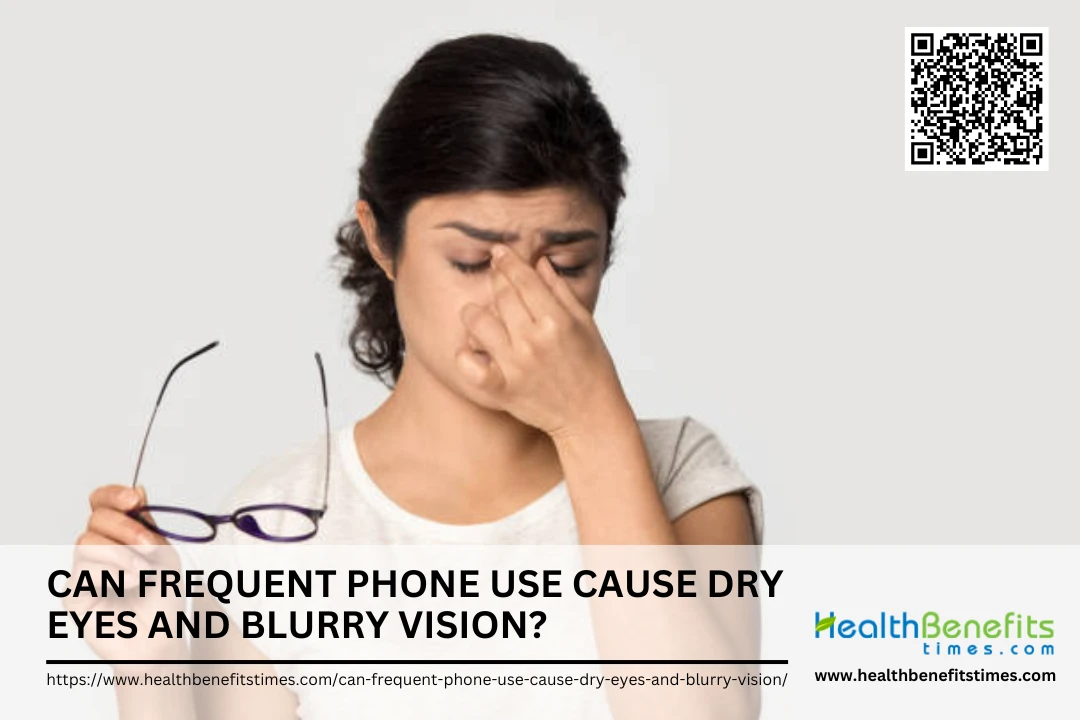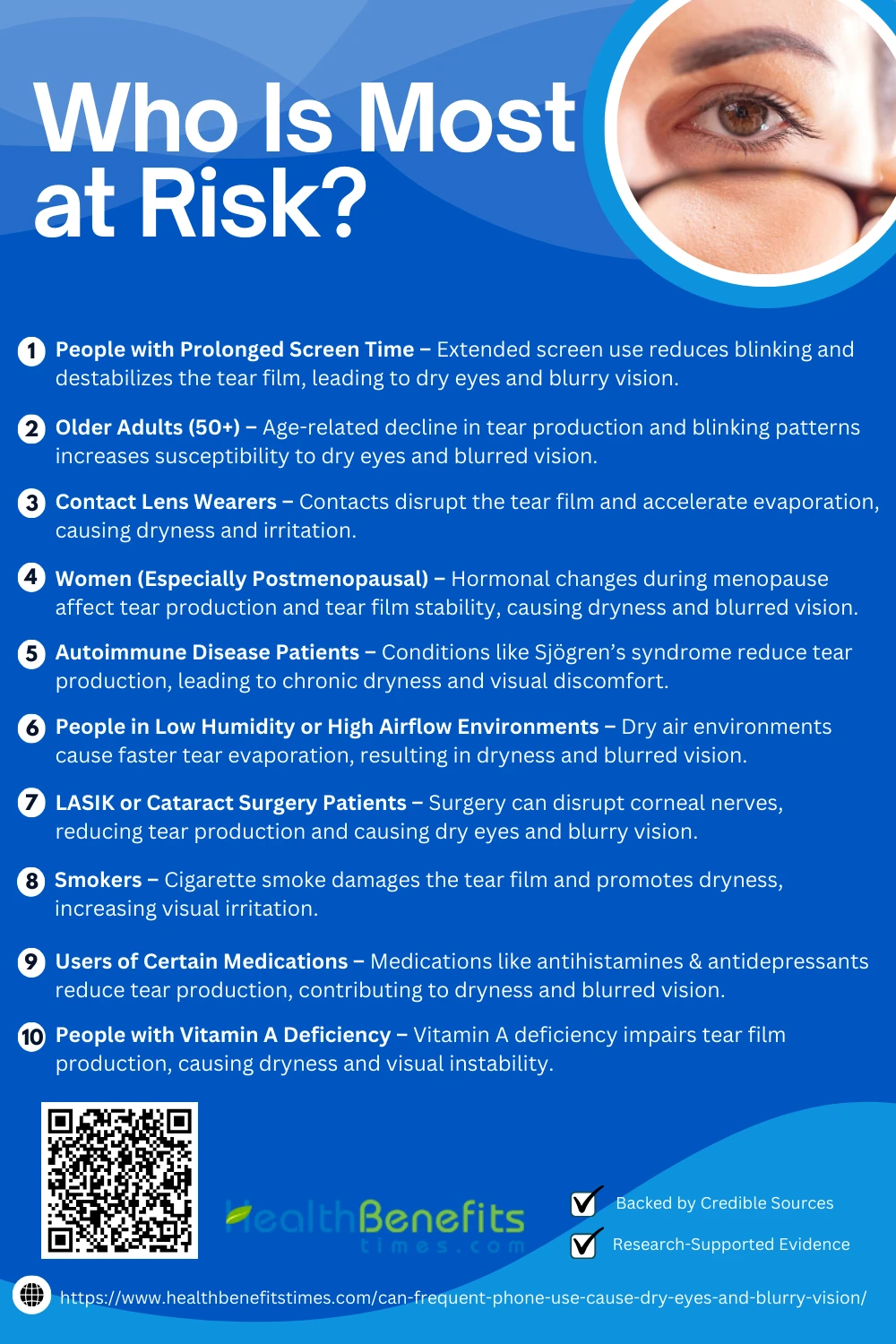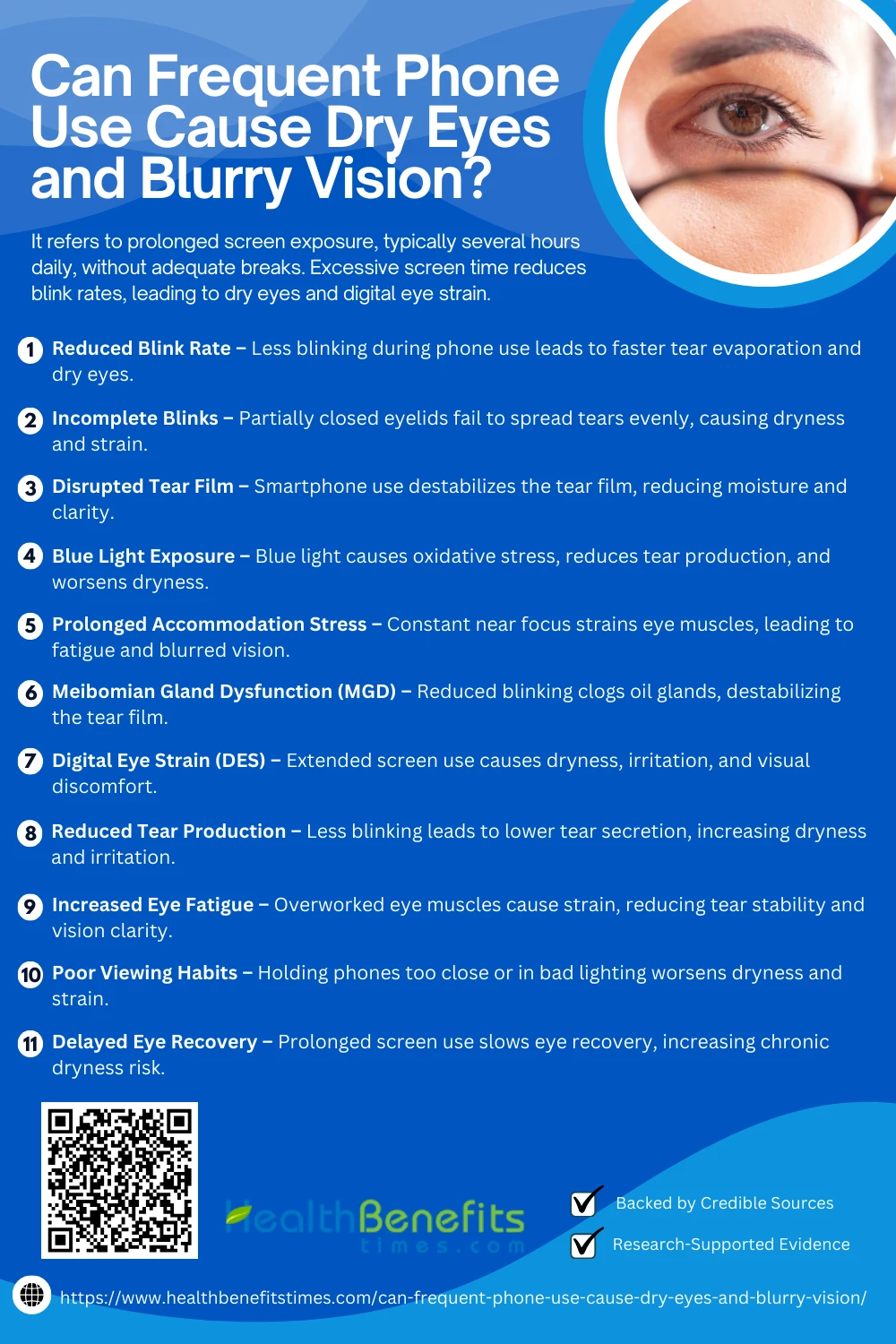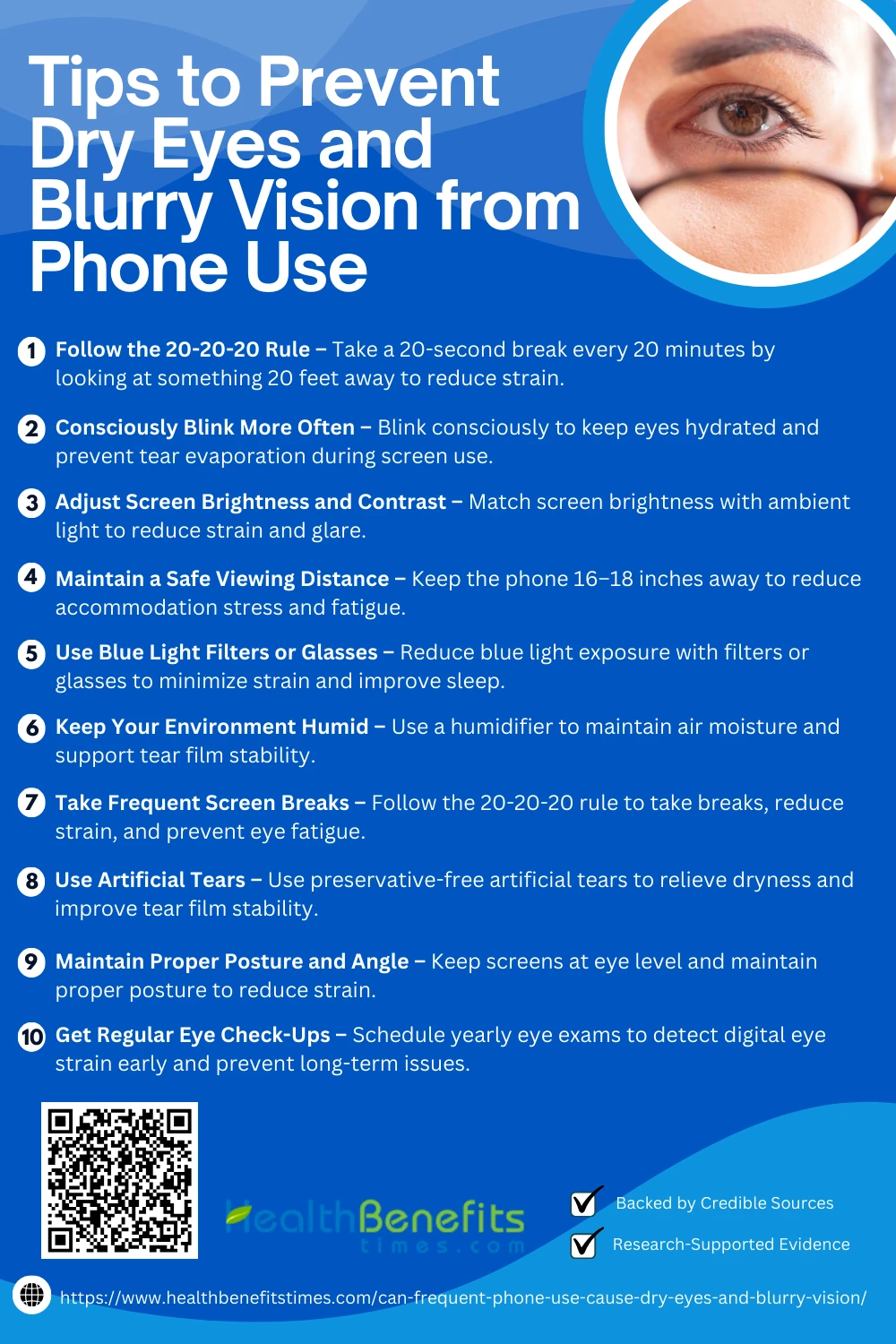- It refers to prolonged screen exposure, typically several hours daily, without adequate breaks.
- Excessive screen time reduces blink rates, leading to dry eyes and digital eye strain.
- Symptoms like blurry vision, irritation, and headaches can worsen without preventive measures such as screen breaks and artificial tears.
 Frequent phone use refers to extended periods of engagement with smartphones, typically exceeding three hours per day, which has been associated with multiple health impacts including visual strain. With smartphones becoming integral to daily life, there has been a noticeable surge in complaints related to eye discomfort, particularly dry eyes and blurry vision. Research has consistently shown that screen time negatively affects tear film stability and blinking patterns, leading to symptoms associated with digital eye strain. A recent study by Moon et al. found that increased smartphone use was directly associated with reduced blink rate and higher incidence of dry eye disease in young adults, underlining how screen behavior impacts ocular physiology (Moon et al., 2016). Furthermore, another investigation highlighted that visual blur is often caused by prolonged accommodation—a condition worsened by staring at small screens at close range.
Frequent phone use refers to extended periods of engagement with smartphones, typically exceeding three hours per day, which has been associated with multiple health impacts including visual strain. With smartphones becoming integral to daily life, there has been a noticeable surge in complaints related to eye discomfort, particularly dry eyes and blurry vision. Research has consistently shown that screen time negatively affects tear film stability and blinking patterns, leading to symptoms associated with digital eye strain. A recent study by Moon et al. found that increased smartphone use was directly associated with reduced blink rate and higher incidence of dry eye disease in young adults, underlining how screen behavior impacts ocular physiology (Moon et al., 2016). Furthermore, another investigation highlighted that visual blur is often caused by prolonged accommodation—a condition worsened by staring at small screens at close range.
Understanding Dry Eyes
Dry eye syndrome is a common ocular condition in which the eyes fail to produce sufficient tears or the tears evaporate too quickly, leading to inadequate lubrication on the eye’s surface. It can arise from various causes, including aging, hormonal changes, medications, and environmental factors.
The symptoms of dry eye syndrome range from mild to severe and often include a gritty or burning sensation, redness, excessive tearing, and intermittent blurry vision. People with the condition may feel as though something is in their eyes or experience discomfort during reading or screen use.
Prolonged digital screen exposure is increasingly recognized as a contributing factor, as it significantly reduces blink rate, leading to decreased tear distribution and increased evaporation.
The Science of Vision and Eye Moisture
The eyes maintain moisture and clarity through a complex tear film composed of lipid, aqueous, and mucin layers that protect the cornea and enable smooth vision. (1) However, digital screens have been shown to drastically reduce blink rate and lead to incomplete blinking, disrupting tear distribution and increasing dryness. (2)
How Frequent Phone Use Cause Dry Eyes and Blurry Vision
Staring at your phone for hours can lead to dry eyes and blurry vision. Learn how frequent screen time affects your eye health and what you can do to protect it.
Frequent phone use significantly reduces spontaneous blinking, a behavior essential for refreshing the tear film and preventing eye dryness. Research has shown that reduced blinking leads to faster tear evaporation and increased ocular discomfort (blink rate study). Screen concentration lowers blink frequency by up to 60%, destabilizing the tear layer. (1) (2) This leads to dry eye symptoms and vision distortion. (3) (4)
2. Incomplete Blinks
Incomplete blinking—where the eyelids do not fully close—is a common issue during prolonged phone use. This compromises the tear film’s ability to cover the eye uniformly, causing exposed areas to dry out. (5) (6) Studies have linked incomplete blinks to higher rates of dry eye disease in digital users. It also affects lipid layer replenishment and exacerbates strain-related blur. (2)
3. Disrupted Tear Film
Smartphone overuse disrupts the stability of the tear film, a crucial protective layer that maintains moisture and optical clarity. (1) Reduced blinking during screen time leads to faster tear evaporation (blink rate study). This results in a thinner, unstable tear layer, impairing vision quality. (2) It also increases friction on the eye surface and reduces optical performance. (7) (4)
4. Blue Light Exposure
Prolonged phone use exposes the eyes to high-energy visible (HEV) blue light, which is linked to oxidative stress and inflammation in ocular tissues (blue light basics). Blue light disrupts tear production and worsens dryness symptoms. (3) It also interferes with melatonin cycles, affecting blinking and moisture balance. (8) Exposure to HEV light can damage corneal epithelial cells and amplify blurry vision. (9)
5. Prolonged Accommodation Stress
Constant smartphone use requires the eyes to maintain near focus, causing prolonged accommodation stress. (4) This overworks the ciliary muscles, resulting in blurry vision and spasms. (7) Sustained near focus also reduces blink frequency, contributing to tear instability (blink suppression study). Eye fatigue impairs visual performance and tear secretion. (2)
6. Meibomian Gland Dysfunction (MGD)
The Meibomian glands produce oils that prevent tear evaporation, but excessive screen use can cause their dysfunction. (3) Reduced blinking leads to gland stagnation and oil buildup. MGD reduces lipid layer thickness, destabilizing the tear film. It also contributes to inflammation on the ocular surface and worsens dry eye disease symptoms. (9)
7. Digital Eye Strain (DES)
Digital Eye Strain (DES), also known as Computer Vision Syndrome, arises from extended screen exposure, particularly smartphones (DES definition). It includes symptoms like dryness, blurry vision, and burning sensations. (2) Long-term screen viewing reduces blink rate and destabilizes tear film. (1) Improper lighting and posture further aggravate visual stress. (6)
8. Reduced Tear Production
Frequent screen time is linked to decreased basal tear secretion, which is vital for maintaining ocular surface hydration. (3) Reduced blinking during smartphone use slows tear distribution and drainage (blink rate effect). This leads to faster evaporation and insufficient lubrication. (1) Chronic dryness impacts vision clarity and comfort, contributing to digital eye strain symptoms. (4)
9. Increased eye fatigue
Prolonged smartphone use overworks the extraocular and ciliary muscles, leading to visual fatigue and reduced accommodation flexibility. (2) The constant close-up focus causes strain and delays recovery. (4) Eye fatigue disrupts tear balance and contributes to blurred vision. (1) It also leads to less frequent blinking, worsening dryness.
10. Poor Viewing Habits
Improper phone viewing habits—like holding devices too close, low brightness settings, or dim lighting—strain the visual system and reduce tear stability. (6) These habits increase blink suppression and disrupt the tear film. (1) Poor posture can worsen eye fatigue and aggravate symptoms of digital eye strain. (2)
11. Delayed Eye Recovery
Extended smartphone use impairs the eyes’ ability to recover from fatigue, especially after prolonged near-focus tasks. Recovery of tear film stability is delayed due to reduced blinking and disrupted meibomian gland function. Eye strain persists beyond screen use, impacting vision quality and increasing the risk of chronic dry eye syndrome. (2) (4)
Who Is Most at Risk?
Certain people are more vulnerable to dry eyes and blurry vision from screen use. Discover who most at risk is and why their daily habits or conditions make them more susceptible.
 1. People with Prolonged Screen Time
1. People with Prolonged Screen Time
Individuals who spend extended hours on smartphones, tablets, or computers are at high risk of developing dry eyes and blurry vision. Prolonged screen time reduces blink rate and leads to incomplete blinking, both of which destabilize the tear film and accelerate evaporation. The result is digital eye strain (DES), characterized by eye fatigue, dryness, and temporary blurred vision, especially after work or gaming sessions.
2. Older Adults (50+)
As we age, tear production naturally declines due to changes in the lacrimal glands and decreased cellular regeneration. This makes older adults more susceptible to dry eye syndrome. Age-related changes in blinking patterns and ocular surface health also contribute to chronic visual discomfort and blurred vision, particularly when compounded by other risk factors such as medication use and comorbidities.
3. Contact Lens Wearers
Wearing contact lenses disrupts the natural tear film and may lead to faster tear evaporation. Over time, this can cause the lenses to become uncomfortable and the eyes to feel gritty or dry. Moreover, improper lens hygiene or overuse can lead to ocular surface damage, increasing the likelihood of blurred vision and chronic irritation.
4. Women (Especially Postmenopausal)
Hormonal fluctuations, particularly the drop in estrogen and androgens during and after menopause, significantly affect tear gland function. Women, especially those postmenopausal, are more likely to experience both aqueous-deficient and evaporative dry eye. Hormonal imbalance can also alter the composition of tears, making them less effective in maintaining a stable, clear visual surface.
5. Autoimmune Disease Patients
Autoimmune diseases like Sjögren’s syndrome, lupus, and rheumatoid arthritis can damage the glands responsible for tear production. In these patients, inflammation often targets the lacrimal glands, leading to chronic dryness and impaired vision. Sjögren’s syndrome, in particular, is one of the leading causes of severe dry eye symptoms that do not respond well to standard over-the-counter treatments.
6. People in Low Humidity or High Airflow Environments
Exposure to dry environments—such as air-conditioned offices, heated rooms, or airplanes—can dramatically increase tear evaporation. Without adequate humidity, the eyes lose moisture faster than it can be replenished, resulting in dryness and blurred visual perception. This environmental risk is often overlooked but highly relevant in urban and professional settings.
7. LASIK or Cataract Surgery Patients
Surgical procedures such as LASIK or cataract removal can damage corneal nerves that regulate tear production. This nerve disruption often leads to reduced blinking reflex and tear secretion in the months following surgery. Many patients report temporary or persistent dry eyes and blurry vision as part of post-operative symptoms.
8. Smokers
Cigarette smoke introduces toxins and oxidative stress to the ocular surface, damaging the tear film and promoting inflammation. Smokers often have decreased mucin production and altered lipid layers in their tears, both of which are vital for tear stability. Chronic exposure to smoke—either actively or passively—exacerbates dryness and visual irritation.
9. Users of Certain Medications
Many medications, such as antihistamines, antidepressants, beta-blockers, and diuretics, reduce tear production as a side effect. These drugs may affect autonomic control of the lacrimal glands or alter hormonal pathways, leading to drier eyes and reduced blink efficiency. Patients taking multiple medications are especially at risk.
10. People with Vitamin A Deficiency
Vitamin A plays a crucial role in maintaining the health of the ocular surface and tear film. A deficiency can result in a lack of goblet cells, which are responsible for producing mucin—the substance that helps tears spread evenly across the eye. This results in dryness, visual instability, and, in severe cases, corneal damage or night blindness.
Tips to Prevent Dry Eyes and Blurry Vision from Phone Use
Preventing dry eyes and blurry vision from phone use is possible with simple habits. Here are effective tips to reduce eye strain and keep your vision comfortable throughout the day.
The 20-20-20 rule—looking 20 feet away for 20 seconds every 20 minutes—helps reduce accommodation stress and visual fatigue. (4) It prevents digital eye strain and maintains tear film integrity. Ophthalmologists recommend it as an effective screen time strategy. (2)
2. Consciously Blink More Often
Blinking is essential to evenly spread tears, yet screen use significantly reduces blink frequency. Conscious blinking prevents tear evaporation and supports ocular hydration. (1) Eye specialists advise blink training during phone use to reduce dryness. (6)
3. Adjust Screen Brightness and Contrast
Proper screen brightness and contrast reduce visual effort and prevent glare-related eye strain. (6) Overly bright screens intensify tear film evaporation. (2) Experts recommend matching screen brightness to ambient light to minimize strain and visual discomfort.
4. Maintain a Safe Viewing Distance
Holding a phone too close increases accommodation demand and muscular fatigue, leading to blurry vision. (4) Recommended viewing distance is 16–18 inches to reduce strain. (6) Safe distance also supports blink rate normalization.
5. Use Blue Light Filters or Glasses
Blue light exposure from screens causes oxidative stress and disrupts tear production. (3) Using blue light filters or glasses can reduce symptoms of digital eye strain. These tools also improve sleep and reduce visual fatigue. (8)
6. Keep Your Environment Humid
Dry air accelerates tear evaporation, worsening dry eye symptoms. (2) Using a humidifier restores ambient moisture and supports tear film stability. (1) Ophthalmologists recommend maintaining at least 40% humidity for comfortable screen viewing.
7. Take Frequent Screen Breaks
Extended screen exposure can cause digital eye strain, leading to dryness and blurred vision. Studies suggest following the 20-20-20 rule—looking away every 20 minutes at an object 20 feet away for 20 seconds—to alleviate strain. Research also highlights that prolonged smartphone use reduces blink rates, exacerbating dryness. (10) Taking frequent breaks can also reduce symptoms of computer vision syndrome, a common issue among digital device users. (11)
8. Use Artificial Tears
Artificial tears help combat dryness caused by excessive screen time, replenishing moisture and stabilizing the tear film. Studies confirm their efficacy in reducing symptoms of dry eye syndrome among digital device users. Preservative-free artificial tears are preferable for frequent use, as they minimize irritation. (12) Regular application can prevent discomfort and improve visual clarity during prolonged screen exposure. (13)
9. Maintain Proper Posture and Angle
Maintaining proper posture and holding devices at an optimal angle reduces eye strain and prevents dry eyes. Studies suggest keeping screens at eye level and at least 16 inches away to minimize glare and stress on the eyes. Poor posture can also affect tear film stability, leading to discomfort. (10) Adjusting screen brightness and contrast further aids in reducing visual fatigue. (11)
10. Get Regular Eye Check-Ups
Routine eye exams help detect early signs of digital eye strain and prevent long-term vision problems. Experts recommend annual check-ups to assess tear production and overall eye health. Eye specialists can provide personalized solutions for dry eye syndrome, including lifestyle changes and treatments. (12) Early intervention ensures optimal vision and prevents complications from prolonged screen exposure. (13)
When to See an Eye Doctor
Regular eye exams are essential for maintaining good vision and detecting potential health problems early. Experts recommend that adults should see an eye doctor every one to two years, but those with risk factors such as diabetes, high blood pressure, or a family history of eye diseases should schedule more frequent visits. Sudden vision changes, persistent eye pain, frequent headaches, or difficulty seeing at night may indicate underlying conditions requiring immediate attention. Additionally, children should have their first comprehensive eye exam at six months, followed by exams at age three and before starting school to ensure healthy visual development. (14) Regular eye check-ups can prevent serious complications and promote long-term eye health.
Conclusion
In conclusion, frequent phone use can contribute to dry eyes and blurry vision due to prolonged screen exposure, reduced blinking, and digital eye strain. Staring at screens for extended periods can lead to discomfort, irritation, and temporary vision disturbances. However, adopting healthy screen habits—such as following the 20-20-20 rule, blinking more often, and ensuring proper lighting—can help alleviate symptoms. If dryness and blurriness persist, consulting an eye specialist is essential to rule out underlying conditions. By being mindful of screen time and practicing good eye care, individuals can protect their vision and maintain overall eye health.




